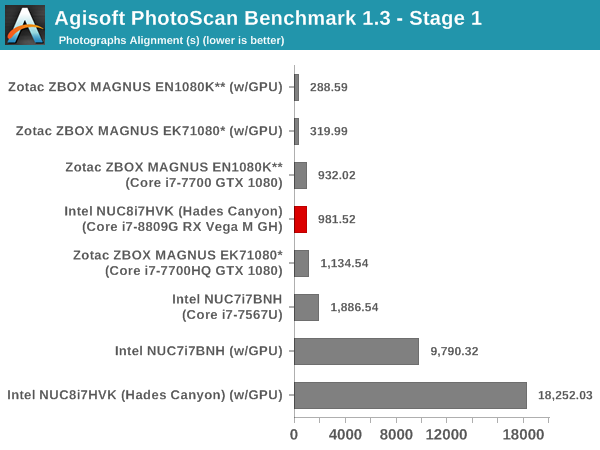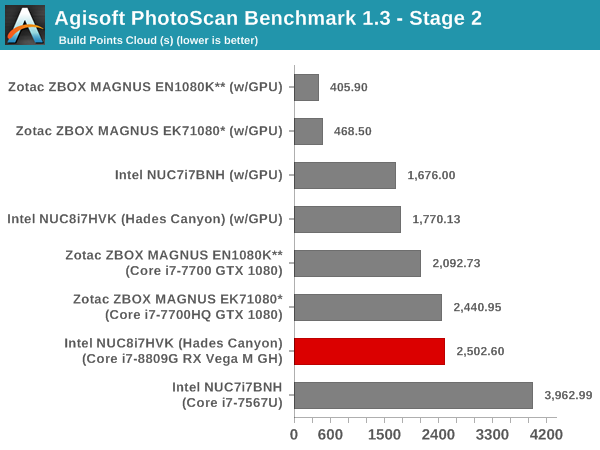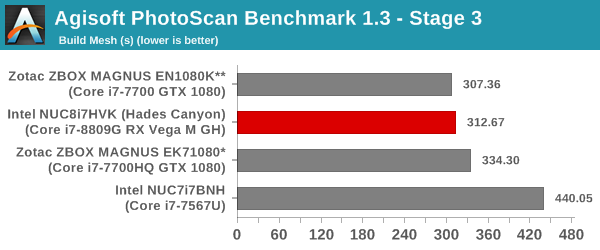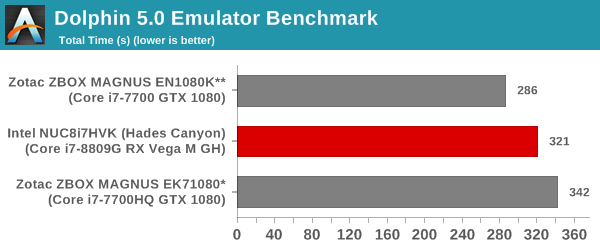The Intel NUC8i7HVK (Hades Canyon) Review: Kaby Lake-G Benchmarked
by Ganesh T S on March 29, 2018 1:00 PM ESTPerformance Metrics - II
In this section, we mainly look at benchmark modes in programs used on a day-to-day basis, i.e, application performance and not synthetic workloads.
x264 Benchmark
First off, we have some video encoding benchmarks courtesy of x264 HD Benchmark v5.0. This is simply a test of CPU performance. As expected, the Core i7-8809G with its 65W processor TDP slots closer to the Core i7-6700 and the Core i7-7700. Recent releases of the x264 benchmark can show even more impressive gains, as they make use of the latest and greatest features of the modern Intel processors.


7-Zip
7-Zip is a very effective and efficient compression program, often beating out OpenCL accelerated commercial programs in benchmarks even while using just the CPU power. 7-Zip has a benchmarking program that provides tons of details regarding the underlying CPU's efficiency. In this subsection, we are interested in the compression and decompression MIPS ratings when utilizing all the available threads. The performance order is similar to the one encountered in the x264 benchmark.


TrueCrypt
As businesses (and even home consumers) become more security conscious, the importance of encryption can't be overstated. CPUs supporting the AES-NI instruction for accelerating the encryption and decryption processes have become more widespread over the last few years. TrueCrypt, a popular open-source disk encryption program can take advantage of the AES-NI capabilities. The TrueCrypt internal benchmark provides some interesting cryptography-related numbers to ponder. In the graph below, we can get an idea of how fast a TrueCrypt volume would behave in the Intel NUC8i7HVK (Hades Canyon) and how it would compare with other select PCs. This is a purely CPU feature / clock speed based test.

Agisoft Photoscan
Agisoft PhotoScan is a commercial program that converts 2D images into 3D point maps, meshes and textures. The program designers sent us a command line version in order to evaluate the efficiency of various systems that go under our review scanner. The command line version has two benchmark modes, one using the CPU and the other using both the CPU and GPU (via OpenCL). We have been using an old version of the program with 50 photogaphs in our reviews till now. The updated benchmark (v1.3) now takes around 84 photographs and does four stages of computation:
- Stage 1: Align Photographs (capable of OpenCL acceleration)
- Stage 2: Build Point Cloud (capable of OpenCL acceleration)
- Stage 3: Build Mesh
- Stage 4: Build Textures
We record the time taken for each stage. Since various elements of the software are single threaded, others multithreaded, and some use GPUs, it is interesting to record the effects of CPU generations, speeds, number of cores, DRAM parameters and the GPU using this software.
The GPU-enabled numbers for Stage 1 and 2 below are with the use of the Intel HD Graphics 630, since our benchmark version only supports use of the first enumerated GPU. Unfortunately, when we tried to disable the integrated GPU and use only the discrete GPU after changing the BIOS setting, the benchmark consistently crashed while starting the first stage itself.




Dolphin Emulator
Wrapping up our application benchmark numbers is the new Dolphin Emulator (v5) benchmark mode results. This is again a test of the CPU capabilities, and the Core i7-8809G slots inbetween the 45W TDP Core i7-7700HQ and the 65W Core i7-7700.











124 Comments
View All Comments
Hifihedgehog - Saturday, March 31, 2018 - link
“The mass market still uses Kodi and VLC.”I respectfully disagree. Many home theater users I know use Kodi in combination with MPC-HC or MPC-BE, due to MadVR highly superior scaling abilities. Check the Kodi forums. This is a very popular configuration:
forum (dot) kodi (dot) tv/showthread.php?tid=209596
Check out this thread. Many reference it. Perhaps you should as welll in going forward:
forum (dot) doom9 (dot) org/showthread.php?t=171787
I have tried VLC 3.0 and CPU usage and image quality are still inferior to MPC-HC and MPC-BE. For these reasons, it is still not worth recommending.
Hifihedgehog - Saturday, March 31, 2018 - link
PS:hardforum (dot) com/threads/vlc-3-0-released-with-hdr-chromecast-support.1954247/#post-1043479175
Trixanity - Saturday, March 31, 2018 - link
Try the latest 3.0.2 nightly. It should work there unless Hades have special drivers.mode_13h - Friday, March 30, 2018 - link
Rabid angry people like you are funny, do you really think anyone is going to read or care about your comment? Go away LOLcfenton - Thursday, March 29, 2018 - link
The claim was about codec support. Just by looking at the DXVA charts it's pretty clear the Intel IGP has better codec support. Hardware decode is pretty important for most people looking for a box to sit near their TV.Of course, you may be right that the Ryzen 5 is a better solution overall if you're willing to sacrifice UHD Blu-ray and some hardware decode ability.
eva02langley - Friday, March 30, 2018 - link
Who the hell is using Blu-Ray anymore?mooninite - Friday, March 30, 2018 - link
People use Blu-Ray when they want to view the best possible video AND audio quality on something other than their laptop with a 1280x768 17" screen that's on shared wi-fi.PeachNCream - Friday, March 30, 2018 - link
Do you mean 1366x768? 1280x800 used to be pretty popular when screens went to 16:10.cfenton - Friday, March 30, 2018 - link
Anyone who cares about image and audio quality, which is precisely the market for an HTPC.bill44 - Thursday, March 29, 2018 - link
As far as I know, no Intel NUC with HDMI 2.x can deal with frame packed 3D ISO.As the Hades Canyon uses AMD GPU's HDMI 2.x output, it may be able to. Can someone test this?